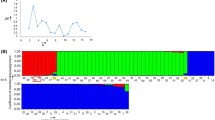Abstract
The wild species of tall fescue (Festuca arundinacea var.genuina Schreb.) represent a wide range of genetic variation and constitute potential germplasm for tall fescue improvement. Our objective was to evaluate genome specificity of the previously-identified DNA probes and to examine the phylogenetic relationship of tall fescue with six related species by using RFLP data. A total of 29 DNA probes from aPstI-genomic library of tall fescue were hybridized toEcoRI-orHindIII-digested DNA of 32 plants from sixFestuca species and fromLolium perenne L. Fifteen probes hybridized to all seven species. The remaining 14 probes showed differential hybridization patterns (i.e., ±), especially at the diploid and tetraploid levels. This hybridization pattern reflected genome divergence in these species. The DNA probes will be useful markers in breeding programs involving interspecific and intergeneric hybridization. Cluster analyses were performed using the average genetic distances calculated with the RFLP data from 53 probe-enzyme combinations. Generally, genotypes from the same species were grouped in the same cluster. These data indicated that tall fescue has a close relationship withF. pratensis Huds. (diploid),F. arundinacea var.glaucescens Boiss. (tetraploid), andL. perenne L. (diploid) and thatFestuca pratensis andL. perenne had the closest degree of relationship.
Similar content being viewed by others
References
Appels R, Moran LB (1984) Molecular analysis of alien chromatids introduced into wheat. In: Gustafson JP (ed) Gene manipulation in plant improvement. Plenum Press, New York London, pp 529–557
Aswidinnoor H, Nelson RJ, Dallas JF, McIntyre CL, Leung H, Gustafson JP (1991) Cloning and characterization of repetitive DNA sequences from genomes ofOryza minuta andOryza australiensis. Genome 34:790–798
Birnboim HC (1983) A rapid alkaline extraction method for isolation of plasmid DNA. Methods Enzymol 100:243–255
Buckner RC, Burris PB, Bush LP (1977) Registration of Kenhy tall fescue. Crop Sci 17:672–673
Buckner RC, Bush LP, Burrus PB II (1979) Succulence as a selection criterion for improved forage quality inLolium-Festuca hybrids. Crop Sci 19:93–96
Buckner RC, Boling JA, Burrus PB II, Bush LP, Hemken RA (1983) Registration of Johnstone tall fescue. Crop Sci 23:399–400
Feinberg AP, Vogelstein B (1984) A technique for radiolabelling DNA restriction fragments to high specific activity. Anal Biochem 37:266–267
Flavell, RB (1980) The molecular characterization and organization of plant chromosomal DNA sequence. Annu Rev Plant Physiol 31:569–596
Lewis EJ, Humphreys MW, Caton MP (1980) Disomic inheritance inFestuca arundinacea Schreb. Z. Pflanzenzüchtg 84:335–341
Malik CP, Thomas PT (1967) Cytological relationship and genome structure of someFestuca species. Caryologia 20:1–39
Rogers J (1972) Measures of genetic similarity and genetic distance: studies in genetics VII. Univ Texas Publ 7213:145–153
Randall DD, Nelson CJ, Sleper DA, Miles CD, Crane CF, Krueger RW, Wong JHH, Poskuta JW (1985) Photosynthesis in allopolyploidFestuca. In: Ludden PW, Burris JE (eds) Nitrogen fixation and CO2 metabolism. Elsevier, New York, pp 409–418
SAS Institute (1985) SAS user's guide: statistics. Version 5. SAS Institute, Gary, North Carolina
Sleper DA (1985) Breeding tall fescue. In: Janick J (ed) Plant breeding review vol 3. AVI Publishing Co., Wesport, Connecticut, pp 313–342
Song KM, Osborn TC, Williams PH (1988)Brassica taxonomy based on nuclear restriction fragment length polymorphisms (RFLPs). 1. Genome evolution of diploid and amphidiploid species. Theor Appl Genet 75:784–794
Terrell EE (1966) Taxonomic implications of genetics in ryegrass (Lolium). Bot Rev 32:138–164
Thomas H, Humphreys MO (1991) Progress and potential of interspecific hybrids ofLolium andFestuca. J Agric Sci, Cambridge 117:1–8
Xu WW, Sleper DA, Hoisington DA (1991) A survey of restriction fragment length polymorphisms in tall fescue and its relatives. Genome 34:686–692
Xu WW, Sleper DA, Chao S (1992) Detection of RFLPs in perennial ryegrass by heterologous probes from tall fescue. Crop Sci 32:1366–1370
Author information
Authors and Affiliations
Additional information
Communicated by D. R. Pring
This paper is a contribution of the Missouri Agricultural Experimental Station, Journal Series no. 11,798
Rights and permissions
About this article
Cite this article
Xu, W.W., Sleper, D.A. Phylogeny of tall fescue and related species using RFLPs. Theoret. Appl. Genetics 88, 685–690 (1994). https://doi.org/10.1007/BF01253971
Received:
Accepted:
Issue Date:
DOI: https://doi.org/10.1007/BF01253971




